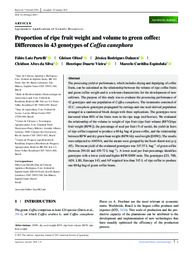Proportion of ripe fruit weight and volume to green coffee: differences in 43 genotypes of Coffea canephora.
Proportion of ripe fruit weight and volume to green coffee: differences in 43 genotypes of Coffea canephora.
Autoria: PARTELLI, F. L.; OLIOSI, G.; DALAZEN, J. R.; SILVA, C. A. da; VIEIRA, H. D.; ESPINDULA, M. C.
Resumo: The processing yield or performance, which includes drying and depulping of coffee fruits, can be calculated as the relationship between the volume of ripe coffee fruits and green coffee weight and is a relevant characteristic for the development of new cultivars. The purpose of this study was to evaluate the processing performance of 42 genotypes and one population of Coffea canephora. The treatments consisted of 42 C. canephora genotypes propagated by cuttings and one seed-derived population arranged in a randomized block design with three replications. The genotypes were harvested when 80% of the fruits were in the ripe stage (red berries). We evaluated the relationship of the volume to weight of ripe fruit (ripe fruit volume [RFV]/ripe fruit weight [RFW]), the percentage of seed per fruit (% of seeds), the yield (in liters of ripe coffee) required to produce a 60-kg bag of green coffee, and the relationship between RFW and dry green bean weight (RFW/dry seed weight [DSW]). The results were subjected to ANOVA, and the means were grouped by the Scott-Knott test (p < .05). The mean yield of the evaluated genotypes was 347.57 L bag-1 of green coffee (between 294.01 and 439.72 L bag-1). A lower seed per fruit percentage identifies genotypes with a lower yield and higher RFW/DSW ratio. The genotypes Z21, 700, AD1, LB1, Emcapa 143, and AP required less than 315 L of ripe coffee to produce one 60-kg bag of green coffee beans.
Ano de publicação: 2021
Tipo de publicação: Artigo de periódico
Unidade: Embrapa Rondônia
Palavras-chave: Analysis of variance, Análise de variância, Café, Café verde, Coffea Canephora, Coffee beans, Comportamento de Variedade, Espírito Santo, Fruit yield, Fruto maduro, Genotype, Genótipo, Green coffee, Método Estatístico, Nova Venécia (ES), Peso, Processamento, Processing technology, Rendimento, Ripe fruit, Semente, Statistical analysis, Variety trials, Volume, Weight
Observações
1 - Por padrão são exibidas publicações dos últimos 20 anos. Para encontrar publicações mais antigas, configure o filtro ano de publicação, colocando o ano a partir do qual você deseja encontrar publicações. O filtro está na coluna da esquerda na busca acima.
2 - Para ler algumas publicações da Embrapa (apenas as que estão em formato ePub), é necessário ter, no celular ou computador, um desses softwares gratuitos. Sistemas Android: Google Play Livros; IOS: iBooks; Windows e Linux: software Calibre.
Acesse outras publicações
Acesse a Base de Dados da Pesquisa Agropecuária (BDPA) para consultar o acervo completo das bibliotecas da Embrapa.

